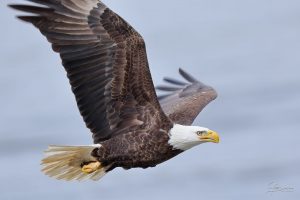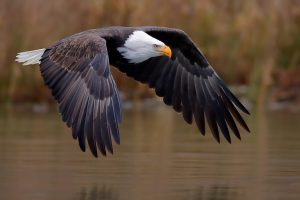Bald Eagles of Conowingo
Feast for the birds ... and for photographers
In case you haven’t been paying attention to bird population statistics, the bald eagle, our national bird, is back in a big way.

Before Europeans arrived in North America, there may have been 400,000 such birds here. But when the Endangered Species Act was passed in 1973, there were fewer than a thousand left, the decline attributed primarily to the effects of the pesticide DDT, which was then banned.
Now the population has rebounded. Delisted as an endangered species in 2007, over 300,000 bald eagles are believed to live in the lower 48 states, with a substantial number in our area.
Wow! Applause for conservationists!
Conowingo Dam

On a fall or winter’s day, visitors to the Conowingo Dam in northern Maryland can see a major settlement of bald eagles. Built in 1928 and now owned by Constellation Energy, the Conowingo Dam spans the Susquehanna River, 12 miles south of Chester County’s southwest tip. Route U.S. 1 runs right over the dam, from Cecil to Harford Counties.
David Marcheskie, Constellation Communication Manager, reports that the number of eagles in the dam’s vicinity is definitely growing. In the winter of 2018, about 230 bald eagles were counted, including local, over-wintering and migrating birds. That’s more than twice the summer numbers. Eagle nests alone have tripled around the dam since 2010.

Bald eagles build their huge nests — the largest in North America — called aeries, about five to six feet in diameter and two to four feet in height. Eagles generally return to the same nest year after year, adding twigs, sticks and grass each season. The aeries are usually built in tall trees in sight of the river. Visitors can see eagles in their nests, perched on branches or power-line towers, or swooping over the river, fishing for their prey.
Many of the bald eagles — the flocks of birds at the dam also include cormorants, gulls, herons, ospreys and about 220 other species — are permanent residents, but in November, they’re joined by eagles migrating south, mainly from the upper Susquehanna River, New York state and Canada.
The birds feast at the dam’s mouth, mostly on shad, herring, eels and other fish, which are expelled from the dam’s giant turbines. The effluent from the dam remains unfrozen in winter, which is why the eagles congregate there to hunt.
Eagles on the Rise
Watching the majestic bald eagles, you can’t help but admire the spectacle. To begin, the eagles are enormous. A mature bird’s wingspan, with long trailing feathers, can reach eight feet wide. The body is thick and muscular, especially the legs, ending with a broad white tail. The yellow talons are about three inches long. A curved yellow beak and alert yellow eyes seem fierce on its “bald” head — actually covered by white feathers.

In October and November, you may see an eagle grab another by its talons in midair. It’s called cartwheeling and is part of their mating ritual. The two spin and glide, falling toward the surface, separating before they hit, and then returning to their nest — males and females look alike, though the females are larger. Eagles mate for life, share nest-building, preen and touch their bills. It’s beautiful to see.
Young eagles are entirely brown and gray — likely for camouflage — and don’t develop their classic white heads until their fifth year. At birth, the eaglets are gray, slightly pink, covered in down. At about five weeks, their plumage emerges, until about 10 weeks, when they become fully feathered. Their beaks and eyes also change, from an initial dark brown, ultimately to yellow. Their white heads and tails announce that the bird is ready to breed.
Hunting at Conowingo Dam
The eagles present as a picture of patient calm, sitting on a high branch or power tower, overseeing the river. Then they lift off, with tremendously powerful wings. Soaring high, surfing the thermals, then swooping down to the water surface. When an eagle spies a fish, it slows slightly, then resumes its flight, weighed down only slightly by the fish dangling below.

That is, if they’re not lazy, which they can be around the Conowingo chum. Dennis Kirkwood, Harford County Birder’s Club past president and Maryland Ornithological Society board member, has watched the bald eagles’ numbers grow from year to year. He says they prefer to scavenge, much like vultures. They also seem clumsy with their meals, frequently dropping the fish they’ve caught. And they don’t like to swim.
In general, Kirkwood views the eagles as “lazy,” inept hunters. He observes their success rate is about 1 in 20, as compared with, say, an osprey, with a much better rate of 1 in 3.
Even when the dam’s sirens go off, indicating a coming water release, attracting the likes of gulls and cormorants from downstream, the eagles are generally complacent. Kirkwood’s take is that they’ll await “easy pickings.”
To See the Bald Eagles
The best bald eagle viewing is on weekdays in late October through December at the Conowingo Dam. Stop at the Visitor Center, 4948 Conowingo Rd., Darlington, MD, open 9 to 5 on weekdays, 11 to 3 on weekends (closed major holidays).
Photographers and other observers tend to gather at Fisherman’s Park on the Harford County (south) side of the dam in Darlington (Cecil County is on the north side). For photographers, we suggest getting there very early, at sun-up, if only to beat the crowds. They’re “shoulder-to-shoulder,” says Kirkwood. And dress warmly!
Calendar note: November 26 is the Harford Bird Club’s Conowingo Dam Gull & Eagle Watch Day.
